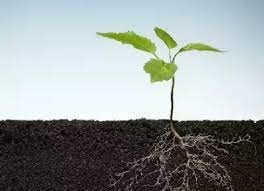Soil improvement is not a short-term matter, it is a systematic project, and the most reasonable farming method and improvement plan must be found.
So, what is the most effective way to improve the soil?
— NO.1 —
The purpose of soil improvement
Increase the organic matter content in the soil, prevent soil compaction, increase the number of beneficial bacteria, inhibit harmful bacteria, adjust the soil pH to neutral, absorb heavy metals, increase ground temperature, improve soil properties, and improve soil fertility and water and fertilizer retention capabilities.
— NO.2 —
The process of soil improvement
1.Soil preservation stage:
In the soil preservation stage, engineering or biological measures are taken to control the amount of soil loss within the allowable range. If the amount of soil loss is not controlled, soil improvement cannot be carried out. For farming soil, the basic construction of farmland must be carried out first.
2.Land improvement stage:
The purpose of the soil improvement stage is to increase soil organic matter and nutrient content, improve soil properties, and improve soil fertility.
Soil improvement measures are mainly planting legume green manure or applying more farm manure.
When the soil is too sandy or too viscous, the method of sand and viscous intermixing can be used.
In some areas of acid red and yellow soil, the eroded soil is lacking in phosphorus. Phosphate fertilizer must be applied when planting green manure crops to improve soil.
Note: One of the purposes of increasing the organic matter in the soil is to cultivate and increase the content of beneficial microorganisms in the soil. The beneficial microorganisms can increase the permeability of the soil, make the soil loose, and reduce the solidification of phosphorus in the soil.
— NO.3 —
Methods of soil improvement
1. Rotate crops in a planned way.
Reasonably arrange the planting of different varieties of vegetables, and try to consider the family type, root depth, fertilizer absorption characteristics, and acidity and alkalinity of secretions of different vegetables.
2. Regularly disinfect the soil.
(1) Pharmacy Law. It can be sterilized by mixing soil with formalin or fumigating with sulfur powder.
(2) Daylight method. During the summer stubble period, remove the shed film, turn the soil deeply, and use ultraviolet rays in the sun to sterilize.
(3) High temperature method. In the hot season, if the shed is filled with water, the soil can also be sterilized by ventilating heat and steam.
(4) Freezing method. In the severe winter, the unusable protective land is removed from the film and the soil is turned deeply to freeze the eggs of the diseased insects.
3. Improve soil texture.
(1) After the vegetables are harvested, turn the soil deeply to mix the surface and deep soil.
(2) Appropriately increase organic fertilizer to increase the content of soil organic matter.
(3) Soils with excessively high salt content or low pH of the topsoil can be replaced by fertile soil.
(4) Soilless cultivation can be carried out if the economic and technical conditions permit.
4. Discharge salt with water.
(1) When stubble is idle, flood water and drench the salt accumulated in the topsoil to reduce the concentration of the soil solution.
(2) In summer, change the stubble pores of vegetables, remove the plastic film and soak in rain or flood with flooding. The salt in the surface layer of the soil will be lost or leached into the deep layer of the soil with the rain.
5. Scientific fertilization.
① Use chemical fertilizers rationally.
When applying chemical fertilizers, it is necessary to pay attention to the lack of fertilizer in the soil and crops. What is missing is what is missing, how much is missing, and how much is missing. Do not over-fertilize for yield. It is best to be able to do soil testing and fertilization, so that a more accurate input of nitrogen, phosphorus and potassium can be achieved.
② Increase the input of organic fertilizers.
The fertility of the soil depends on the amount of organic matter in the soil. Applying organic fertilizer can supplement the soil organic matter. Organic fertilizers contain a large amount of organic matter and are a place where various microorganisms grow and breed.
According to research, deep tillage combined with the application of organic fertilizer, soil nitrogen-fixing bacteria nearly doubled compared with the control, fiber decomposing bacteria increased nearly 2 times, and other microbial communities also increased significantly, so the application of organic fertilizer can greatly promote the maturation process of newly reclaimed land.
Organic fertilizer has strong cation substitution ability, can absorb more potassium, ammonium, magnesium, zinc and other nutrients, prevent leaching and improve soil fertilizer capacity.
In addition, organic fertilizer also has a strong buffering capacity, which can prevent soil acidity changes and soil compaction caused by long-term application of chemical fertilizers, improve the soil’s own stress resistance, and ensure a good soil ecological environment.
③ Apply beneficial biological bacteria fertilizer to the soil.
Through the life activities of microorganisms, the ion exchange frequency of the soil aggregate structure can be increased, and the relative quality of the soil can be reduced, thereby increasing the contact rate of crops and soil organic matter, and improving the structure of the soil.
Secondly, microorganisms can form metabolism through life activities, thereby effectively absorbing the original harmful substances in the soil and forming a new microbial system; this can improve the soil environment and reduce soil pathogens.
④ Increase the application of soil conditioners.
Practice has proved that long-term application of soil conditioners has a special effect on loosening soil, improving soil aggregate structure, and adjusting soil pH!
6. Kind of salt-tolerant crops.
After vegetables are harvested, planting crops such as corn, sorghum, and cabbage with strong fertility can effectively reduce the salt content and acidity of the soil. If the soil has salt accumulation or strong acidity, vegetables with strong salt tolerance can be planted, such as spinach, celery, etc. Eggplant, etc., or vegetables with strong acid tolerance, such as rape, water spinach, taro, etc., in order to achieve the purpose of absorbing soil salt.
7. Method of digging and filling sand.
As the saying goes, “Paving sand on alkaline ground flourishes crops.” For the land with serious salinization, it is best to dig pits according to the row spacing and plant spacing. The size of the pit is generally about 1000px×1000px×1000px (length×width×depth). After the saline soil in the pit is dug out, fill it in Plant on sandy soil after watering.
8. Loosen the soil in time after irrigation.
Through this measure, the soil temperature can be increased, the soil is loosened, the moisture content is reduced, and the evaporation of water can be reduced. It can also suppress all the weeds that grow in the early spring underneath, which has a significant effect on reducing the death of trees and promoting the growth of young trees. .
9. Cover the ground.
Covering the ground is the proper use of waste organic matter or planting ground to cover the soil surface with plants, which can reduce water evaporation, inhibit soil back alkali, reduce ground runoff, and increase soil organic matter content. Covering materials are best taken locally, based on the principles of economy and applicability, and commonly used crop straws, leaves, bark, etc.


